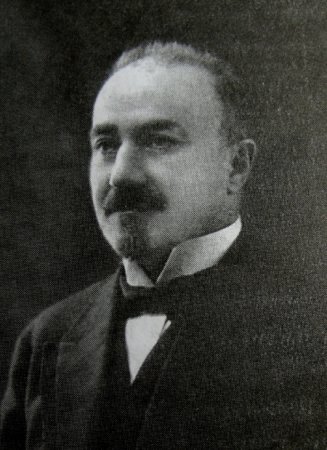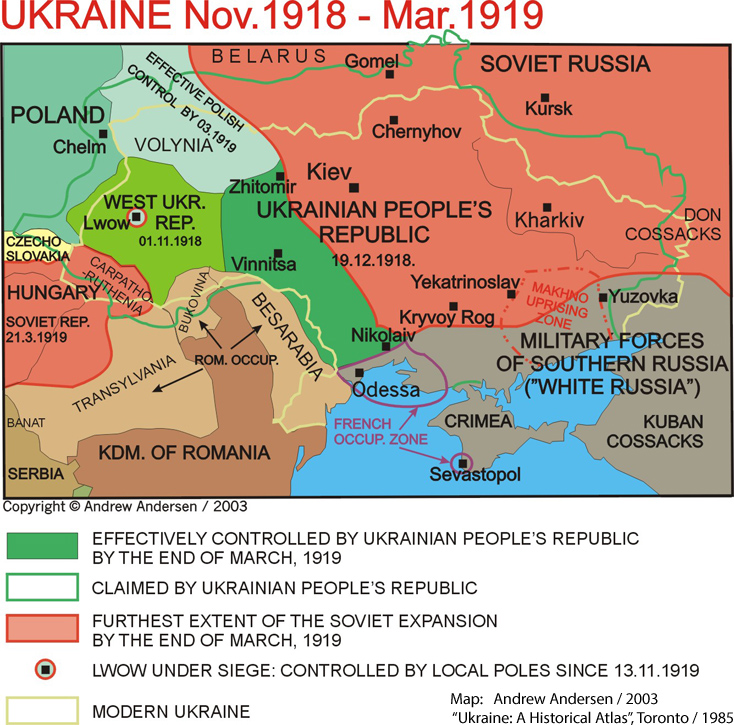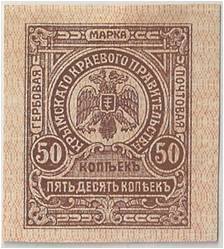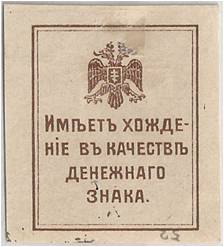ALBUM – view my Crimean Border Government Album
TRANSITION CHART – Ukraine and South Russia
Fast Facts
Region: Russia Area
Group: Ukraine and South Russia
Classification: Revolutionary Government
Prior Regime: German Occupation of Crimea
Key Dates:
1917, Sept – Bolshevik Government led by Vladimir Lenin established
1918, Apr/May – German offensive took control of Crimea
1918, Jun 25 – Germans establish Crimean Government led by Gen. Maciej Sulkevich
1918, Nov – Germans withdraw from Crimea, Sulkevich government falls
1918, Nov – Crimean Border Government established under Solomon Krym
1919, Apr – Allies withdraw from Crimea, Red Army takes over
1919, Jun – White Army under General Denikin drives out Red Army
1920, Nov – Wrangel evacuates the White Army in Crimea and the Bolsheviks take control
Following Regime:Crimea under the White Army control
Scott Catalogue: (South Russia) #52 (also pick #s369)
Pick Catalogue: (Ukraine and Crimea) #s369-372
History

Finally, in March of 1917, the people, fed up with the massive casualties caused by the war, and chronic food shortages within the nation, revolted and forced Tsar Nicholas to abdicate the throne. A provisional government was formed based on democratic principles, but was overthrown a few months later in Sept of 1917 by the Bolshevik movement (the Red Army), led by Vladimir Lenin. This new, government (which became the Russian Soviet Federative Socialist Republic) began a long and bloody campaign to unite the former Russian Empire under the communist banner. Chaos broke out across the country, and in July 1918 the Bolsheviks had the royal family killed to avoid having them serve as a focal point for the anti-Bolshevik movement (the White Army).
Crimea is a large peninsula which sits out in the Black Sea has been for centuries the home of the Crimean Tartars, and was part of the Russian Empire since 1783. By the time of the 1917 Revolution, Crimea was made up of a mixed population including Tartars, Moslems and Kariate Jews. After the October Revolution, the local Tartars proclaimed an independent “Crimean People’s Republic”, but within a few months, it was crushed by the Bolsheviks. Taking advantage of the turmoil in Russia, German forces in the Ukraine took Crimea in Apr/May 1918, and on 25 Jun, 1918 established a Crimean puppet government lead by General Maciej Sulkevich. The region remained under German “protection” until the end of the war.
 After the defeat of Germany in World War 1, German forces withdrew from Crimea in November of 1918, and the unpopular pro-German government of General Sulkevich was quickly disposed. An anti-Bolshevik government, called the Crimean Regional Government was established on 16 Nov, 1918 led by Solomon Krym, a Kariate Jew and a former member of the state senate, who had opposed Sulkevich during the occupation.
After the defeat of Germany in World War 1, German forces withdrew from Crimea in November of 1918, and the unpopular pro-German government of General Sulkevich was quickly disposed. An anti-Bolshevik government, called the Crimean Regional Government was established on 16 Nov, 1918 led by Solomon Krym, a Kariate Jew and a former member of the state senate, who had opposed Sulkevich during the occupation.
Krym was a member of the Constitutional Democratic Party (often called Kadets) which was a liberal political party within the Russian Empire and was formed in 1905. The Kadets were strong advocates of universal suffrage and the formation of a democratic/constitutional type of government, and many of the officials appointed in the new government were fellow Kadets.
Although Krym was well liked by the local populace, like Sulkevich he had little real power. After the defeat of the Germans and Ottomans in the war, Allied forces sailed into the Black Sea taking various strategic ports. The French Navy captured Odessa in south Ukraine, and landed in Sevastopol along with other Crimean ports. The Crimean Border Government relied on the French forces for stability because their presence kept the Red Army out of Crimea.
Krym also approached the leaders of the White Army for support of the new government, but such support was not forthcoming; primarily because Kryms political affiliations caused Denikin and his leaders to question his loyalty to their cause. Due to the ongoing fighting in Russia, the presence in Crimea was short. The French withdrew from Sevastopol on 15 Apr 1919, and signed an armistice with the Bolsheviks 3 days later on the 18th. The Red Army took over Crimea within a matter of days and the Crimean Regional Government collapsed. Solomon Krym and his officials evacuated Crimea to France.
The Red Army victory was short lived, as in June 1919, General Anton Denikin’s White Army swept into Crimea and forcing Bolshevik forces to flee. General Denikin commanded the large White Army which controlled most of the territory in Southern Russia. The Whites continued to push its troops north towards Moscow until they were decisively defeated in Orel in October, 1919. From this point forward, Denikin’s Army slowly retreated south, ultimately consolidating in Crimea. On 20 Mar 1920, Denikin was forced to resign and leadership passed on to Pyotr Nikolayevich Wrangel. While General Wrangle attempted to create a stronghold in Crimea and North Tavria while trying to establish a coalition with other Anti-Bolshevik republics, in reality it was too late as the strength and momentum of the Red Army was too great. After several major losses and continued retreat, Wrangle organized a mass evacuation from Crimea in Nov 1920 rather than leave his men to the wraith of the advancing Communists.
Stamps
 ALBUM
ALBUM
Early in 1919, a 50 kopeck imperforate stamp was issued which contained a circle enclosing the Coat of Arms. Inscribed were the words “Crimean Border Government” in Russian along with the words “revenue” and “postage”. The stamp was issued for both postage use as well as for currency. Issued on thick paper, the reverse was printed with the double headed eagle arms along with he words roughly translated “Circulates as currency”. While these stamps were issued for postage, their primary use was as currency.
For other Crimean Stamps see Crimea, German Occupation (1918) and Crimea under White Army Control (1919-20).
Banknotes
 In addition to the combination postage stamp / currency mentioned above with a denomination of 50 kopecks, three regular banknotes were issued in the denomination of 5, 10 and 25 rubles.
In addition to the combination postage stamp / currency mentioned above with a denomination of 50 kopecks, three regular banknotes were issued in the denomination of 5, 10 and 25 rubles.
Links
SOVIET-UKRAINIAN WAR (1917 – 1921) by Arkadiy Zhukovsky
History of Crimea – Wikipedia
Banknotes of Ukraine and Crimea from AST notes




